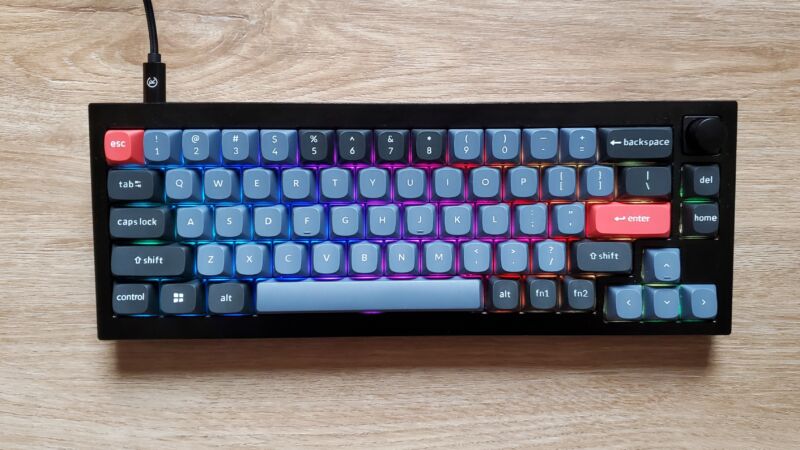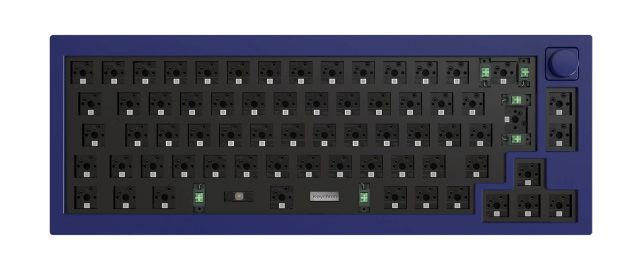
Scharon Harding
Not everyone appreciates the luxury of a mechanical keyboard. Many are happy with the flat keys that come with their laptop; they don’t need to deal with the price premiums, varieties, and complexities of mechanical switches. Among those who do make the leap to mechanical switches, plenty are happy to settle on a keyboard preloaded with a specific switch type. But the Keychron Q2 is for those wiling to go an inch or two further down the rabbit hole.
I say “an inch or two” because the Q2 comes completely assembled (or with just the switches and keycaps missing), letting you pick your level of customization—and it offers options that only a mechanical keyboard enthusiast would consider.
| Specs at a glance: Keychron Q2 | |||
|---|---|---|---|
| Cheapest | Most expensive | As reviewed | |
| Switches | None, hot-swappable | Gateron G Pro Red, Blue, or Brown, hot-swappable | |
| Keycaps | Doubleshot PBT | ||
| Connectivity options | USB-C to USB-C cable, USB-C to USB-A adapter | ||
| Backlighting | RGB | ||
| Size (without keycaps) | 12.89 x 4.76 x 0.79-1.33 inches (327.5 x 121 x 20-33.8 mm) | ||
| Weight | ~3.13 lbs (1,420 g) | 3.63 ± 0.02 lbs (1,645 ± 10 g) | |
| Warranty | 1 year | ||
| Price (MSRP) | $149 | $179 | |
| Other perks | Barebones kit; keycap puller; switch puller; screwdriver; hex key; 4x extra gaskets; 2x extra rubber feet; 2x extra hex screws; 2x extra Philips screws | Pre-assembled with volume knob; keycap puller; switch puller; screwdriver; hex key; 4x extra gaskets; 2x extra rubber feet; 2x extra hex screws; 2x extra Philips screws | |
Those options include a gasket-mounted design, sound-dampening foam, and pre-lubricated switches, which should eliminate pinging noises or cheap stabilizer rattling. The Q2 is a surprisingly hefty 65% keyboard built for the long haul, and while the starting price of $150 isn’t cheap, it’s more digestible than other high-end rivals.
Purchasing options
As with some of its other keyboards, including the wireless Keychron K14, Keychron offers numerous options when purchasing a Q2. You can get it as a fully functional keyboard with pre-installed mechanical switches and keycaps, or you can get it as a barebone kit (no switches or keycaps). The barebone kit is a great option for enthusiasts who want more customization than a prebuilt model—but don’t want to build a mechanical keyboard from scratch. The barebone option is only $20-$30 cheaper than the fully assembled version, so it’s not worth choosing just to save money.

Whether you get the keyboard assembled or not, you’ll have to decide if it will have an Insert key, like a traditional 65% keyboard, or a rotary knob. The knob is $10 extra, but you can interact with it in three ways (clockwise turn, counterclockwise turn, and pressing in). The knob is programmable, so you could actually set it up to serve as Insert, too.
You also have three color options, with the chassis being either black, gray, or blue, and the assembled Q2 comes with Gateron G Pro Red, Blue, or Brown switches (all the same price).
Exemplary but imperfect sound
The Q2 looks and feels unique, but what truly sets it apart is a lack of aural artifacts. I tested the Q2 with G Pro Brown switches. Each key press had a gentle plastic noise when going down and a more excited plastic noise with a bit more pop to it on the way up. I heard no metallic pinging noises, even when bottoming out frequently. I recklessly bashed large buttons, like Spacebar and Backspace, but there was no stabilizer rattling to rat on me. All I heard was the sound of well-lubricated switches actuating, a gentle clack from the keycaps—and hollow clunks from the Spacebar and other large keys.
That hollow sound contrasted with the rest of the keyboard; someone even asked me if I was typing on two different keyboards. (I also heard a rare, quiet echo when pressing the right Shift key hard.) Some enthusiasts hate a hollow-sounding key, but what bothered me more was how different the bigger keys sound from the others.



